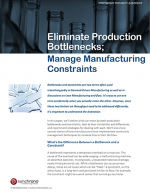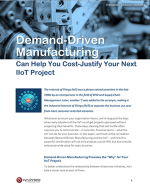Eliminate Production Bottlenecks; Manage Manufacturing Constraints
In this paper, we’ll define what we mean by both production bottlenecks and constraints, look at their similarities and differences, and recommend strategies for dealing with each.
Bottlenecks and constraints are two terms often used interchangeably in Demand-Driven Manufacturing as well as in discussions on Lean Manufacturing and flow.
It’s easy to use one term accidentally when you actually mean the other.
However, since these two limiters on throughput need to be addressed differently, it’s important to understand the distinction.
What’s the Difference Between a Bottleneck and a Constraint?
A bottleneck represents a temporary overload on a resource. The cause of the overload can be wide-ranging: a malfunctioning machine, an absentee operator, missing tools, unexpected materials shortage, newly hired personnel, etc. While a bottleneck can cause serious delays, these are all issues which can be “fixed.”
A constraint, on the other hand, is a long-term and persistent limiter to flow. For example, the constraint might be a work center that cannot go any faster because the equipment is already operating at maximum speed or a process, such as a chemical reaction, that takes a set amount of time.
There are other types of constraints on throughput that don’t have to do with production capacity. For instance, an onerous regulation or a persistent shortage of raw materials can limit your ability to fill orders. In this paper, however, we will just consider internal production constraints as these are the constraints over which production managers have the most control.
What’s Related




Favorites





